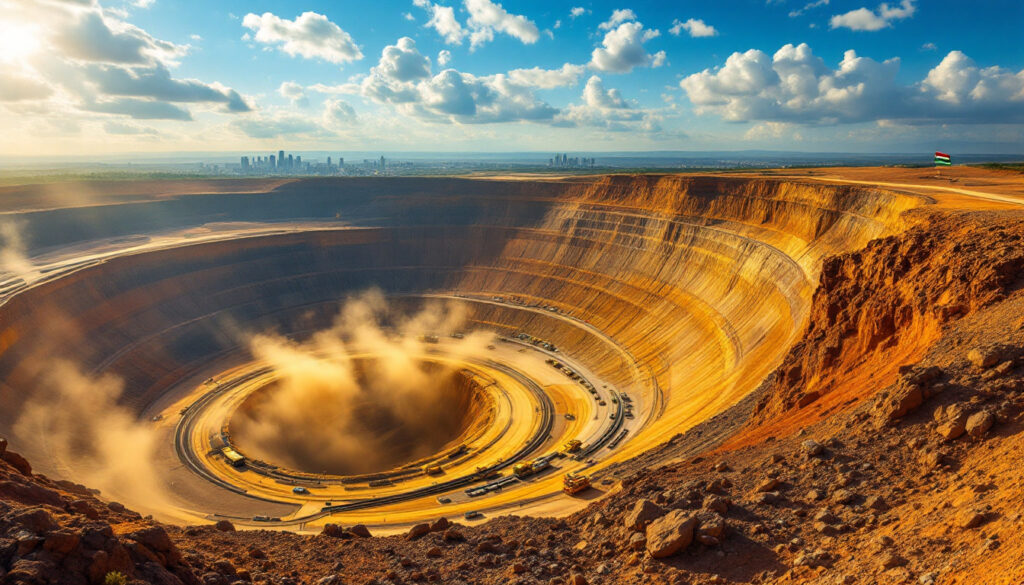What Are the Top 5 Richest Mineral Deposits in the World?
The global mining industry relies on exceptionally valuable mineral concentrations that fuel our modern economy. These extraordinary geological formations contain immense wealth in precious metals, industrial minerals, and gemstones that power technology, construction, and luxury markets worldwide. Let's explore the five most valuable mineral deposits on Earth and understand their significance to global industries.
How Is the Witwatersrand Gold Deposit Transforming South Africa's Economy?
The World's Largest Gold Reserve
The Witwatersrand Basin in South Africa stands as Earth's premier gold repository, containing an estimated 2+ billion ounces of gold—approximately 40% of all gold ever mined globally. This geological wonder stretches across a 300km arc through the Gauteng province, featuring uniquely concentrated gold-bearing conglomerates deposited over 2.8 billion years ago.
The basin's formation resulted from ancient river systems that transported and concentrated gold particles in sedimentary layers. Geologists believe the gold originated from erosion of even older gold-bearing rocks, creating what mining experts call "fossil placer deposits"—a rare geological phenomenon that made the Witwatersrand uniquely valuable.
Historical Impact and Economic Transformation
The 1886 discovery by George Harrison triggered one of history's most significant gold rushes, fundamentally reshaping South Africa's development trajectory. Within a decade, Johannesburg emerged from empty grassland to surpass Cape Town as South Africa's largest urban center. This remarkable transformation included:
- The establishment of Africa's first major railway network
- Creation of thousands of mining jobs
- Development of sophisticated financial markets
- Formation of major mining corporations like Anglo American
Welsh mineralogist John Henry Davis made the initial gold discovery in the region in 1852 at Pardekraal farm in Krugersdorp, but the full scale of the deposit wasn't recognized until decades later. The subsequent "Mineral Revolution" restructured South Africa's economy, labor systems, and social structures while attracting unprecedented international investment.
Legacy and Modern Significance
Today, despite declining production, these mines continue to yield significant gold volumes through increasingly sophisticated deep-level mining techniques. Modern Witwatersrand operations extend to depths exceeding 4 kilometers—making them among the world's deepest mines.
The basin's continued importance to South Africa's economy goes beyond direct mining revenues. The financial, engineering, and logistics infrastructure built around these deposits remains crucial to the nation's economic framework. Mining technology innovations developed for the Witwatersrand's challenging conditions have been exported globally, creating a knowledge economy that transcends the physical gold itself.
"The Witwatersrand isn't just a gold deposit—it's the geological formation that built modern South Africa and revolutionized global mining practices," notes mining historian Robert Thompson.
Why Are Russia's Norilsk Nickel Deposits Strategically Critical?
Siberia's Metal Powerhouse
Located in the remote Siberian region of Russia, the Norilsk Nickel deposits represent one of the world's most valuable concentrations of industrial metals. This extraordinary geological formation contains:
- The world's largest nickel reserves
- Massive copper concentrations
- The largest known palladium deposits globally (approximately 40% of world supply)
- Significant platinum and cobalt resources
The Norilsk deposits formed through massive magmatic intrusions around 250 million years ago. Molten rock rich in metal sulfides solidified into the mineral-laden formations we see today. This rare geological process created an unprecedented concentration of commercially valuable metals in a single location.
Industrial Significance and Applications
The strategic importance of these deposits extends across multiple industries:
| Metal | Primary Applications | Global Supply Contribution |
|---|---|---|
| Nickel | Stainless steel, batteries, aerospace alloys | Largest global producer |
| Palladium | Automotive catalytic converters, electronics | ~40% of world supply |
| Copper | Electrical wiring, construction, renewable energy | Major global contributor |
| Platinum | Jewelry, industrial catalysts, medical equipment | Significant producer |
| Cobalt | Lithium-ion batteries, superalloys | Notable contributor |
The Norilsk complex has become increasingly strategic as the world transitions to electric vehicles and renewable energy systems. Battery technologies rely heavily on nickel, while electrical infrastructure requires substantial copper resources. The deposits' diverse mineral portfolio provides resilience against market fluctuations affecting any single commodity.
Environmental Considerations
While economically vital, the Norilsk mining complex faces significant environmental challenges, including sulfur dioxide emissions and heavy metal contamination. The remote Arctic location presents unique operational challenges while also complicating environmental remediation efforts.
Recent technological innovations aim to reduce the operation's environmental footprint through improved emissions control, waste management, and energy efficiency measures. However, balancing resource extraction with ecological responsibility remains an ongoing challenge for this strategically critical mineral complex.
What Makes Australia's Olympic Dam a Unique Polymetallic Giant?
South Australia's Mineral Treasure
Olympic Dam in South Australia stands as one of the world's most remarkable polymetallic deposits, containing an extraordinary combination of:
- The world's largest known uranium resource (approximately 1 million tonnes)
- Fourth-largest copper deposit globally
- Significant gold reserves (over 25 million ounces)
- Substantial silver concentrations
Discovered in 1975 by Western Mining Corporation, this massive deposit lies beneath 350 meters of cover rock in South Australia's outback. It represents a classic example of an iron oxide-copper-gold (IOCG) deposit—a relatively rare geological formation created through hydrothermal processes.
Mining Operations and Technology
Operated by mining giant BHP, Olympic Dam employs both open-pit and underground mining techniques to access its vast mineral wealth. The operation features:
- Advanced ore processing facilities
- Integrated metallurgical operations
- Sophisticated environmental management systems
- Comprehensive water recycling infrastructure
- Dedicated power generation capabilities
The deposit's complexity requires innovative processing techniques to separate and recover multiple valuable minerals efficiently. Olympic Dam pioneered several metallurgical approaches that have since been adopted by mining operations worldwide.
Economic Impact and Future Development
Olympic Dam contributes significantly to Australia's mineral export economy, with expansion plans potentially increasing production capacity substantially. The site's diverse mineral portfolio provides resilience against market fluctuations in any single commodity, making it a cornerstone of Australia's mining sector.
The deposit's uranium component has grown increasingly important as nuclear energy experiences renewed interest as a low-carbon power source. Simultaneously, copper demand continues rising with global electrification trends and modern mining innovations and renewable energy infrastructure development.
"Olympic Dam represents a geological anomaly of global significance—few deposits combine such diverse, high-value minerals in economically recoverable concentrations," explains Dr. Sarah Mitchell, economic geologist.
How Does Chile's Escondida Mine Dominate Global Copper Production?
The Atacama Desert's Copper Giant
Nestled in Chile's remote Atacama Desert, the Escondida copper mine reigns as the world's largest copper producer. This extraordinary deposit features:
- Approximately 5% of global copper production
- Some of the highest-grade copper ores commercially mined
- Substantial molybdenum reserves as a valuable byproduct
- Exceptional operational scale and efficiency
Escondida formed through porphyry copper mineralization approximately 35 million years ago. Heated fluids circulating through fractured rock deposited copper sulfides in concentrations far exceeding typical copper deposits. At 0.8-1.2% copper content, Escondida's ore grades substantially exceed the global average, making extraction particularly economical despite challenging conditions.
Operational Scale and Technology
Since beginning operations in 1990, Escondida has developed into a mining marvel operated by BHP and Rio Tinto. The operation encompasses:
- Massive open-pit mining operations
- Advanced leaching and concentration facilities
- Desalination plants to support water needs in the arid environment
- Sophisticated logistics networks connecting to global markets
- Renewable energy infrastructure to reduce carbon footprint
The mine's water management systems deserve particular attention. Located in one of Earth's driest deserts, Escondida has invested billions in desalination facilities and pipeline infrastructure to secure water supplies while minimizing impacts on scarce regional water resources.
Economic Significance for Chile
Copper represents Chile's economic backbone, with Escondida serving as the flagship operation. The mine generates:
- Approximately 10% of Chile's GDP
- Over 2,500 direct employment positions
- Thousands of additional indirect jobs
- Substantial tax and royalty revenues
- Infrastructure development throughout northern Chile
This single mining complex has transformed Chile into the world's premier copper-producing nation, positioning the country as a key supplier to global technology and construction markets.
Why Are South Africa's Kimberley Diamond Mines Historically Significant?
Birthplace of Modern Diamond Mining
The Kimberley Diamond Mines in South Africa's Northern Cape province revolutionized the global diamond industry following their discovery in the 1870s. These historic deposits:
- Produced the legendary 3,106-carat Cullinan Diamond in 1905
- Yielded approximately 14.5 million carats (2,722 kilograms) of diamonds between 1871-1914
- Required the excavation of approximately 22.5 million tons of rock
- Established South Africa as the world's diamond capital
The Kimberley deposits' geological significance stems from their kimberlite pipe formation—volcanic conduits that transported diamonds from the Earth's mantle approximately 90 million years ago. These natural pipelines brought diamonds from depths exceeding 150 kilometers to near-surface positions where they could be commercially recovered.
Industry Transformation and Corporate Development
The Kimberley diamond rush catalyzed the formation of De Beers Consolidated Mines under Cecil Rhodes, establishing a company that would dominate global diamond markets for over a century. This concentration of capital and mining expertise transformed diamond mining from individual prospecting to industrial-scale operations.
The Kimberley mines introduced several mining innovations that revolutionized mineral extraction globally:
- Mechanized hauling systems
- Industrial-scale sorting and processing
- Comprehensive security protocols
- Formalized diamond valuation procedures
These technological and organizational advancements spread throughout the mining industry, influencing practices far beyond diamond extraction.
Heritage and Modern Relevance
While large-scale mining has ceased at the original Kimberley sites, their historical significance remains immense. The "Big Hole" excavation stands as a monument to mining history and tourism attraction, while the legacy of these deposits continues to influence global diamond markets and South African mining practices.
The Kimberley mines established fundamental diamond industry structures that persist today, including:
- Centralized sales and distribution systems
- Standardized grading and valuation practices
- Integrated production and marketing strategies
- Concentrated market control
These organizational innovations arguably proved as valuable as the physical diamonds themselves, reshaping global luxury markets and establishing enduring business models.
How Do These Mineral Deposits Compare in Global Importance?
Comparative Economic Impact
Each of these extraordinary deposits has transformed regional economies and global mineral markets:
| Deposit | Primary Resources | Global Significance | Economic Impact |
|---|---|---|---|
| Witwatersrand | Gold | 40% of all gold ever mined | Established Johannesburg, transformed South Africa |
| Norilsk | Nickel, Palladium, Copper | World's largest nickel producer | Critical to automotive and steel industries |
| Olympic Dam | Uranium, Copper, Gold | World's largest uranium resource | Major contributor to Australia's mineral exports |
| Escondida | Copper | 5% of global copper production | Backbone of Chile's export economy |
| Kimberley | Diamonds | Revolutionized diamond industry | Established modern diamond mining practices |
Future Outlook and Sustainability
These deposits face varying challenges and opportunities:
-
Witwatersrand: Declining production but continuing technological innovation in deep mining and reprocessing historic tailings. Environmental remediation of legacy mining sites presents ongoing challenges.
-
Norilsk: Environmental challenges balanced against strategic metal importance, particularly as electric vehicle production accelerates demand for nickel and other battery metals.
-
Olympic Dam: Expansion potential with growing uranium demand for nuclear energy, though water availability and processing costs remain limiting factors.
-
Escondida: Water scarcity challenges in the Atacama Desert driving investments in desalination technology and renewable energy to maintain production sustainability.
-
Kimberley: Historical significance overshadowing current production, with heritage value now potentially exceeding remaining mineral potential.
These deposits' long-term viability depends increasingly on technological innovation, environmental management, and community engagement rather than simple resource abundance. Modern mining approaches emphasize efficiency, sustainability, and social responsibility alongside traditional productivity metrics.
FAQ: Understanding the World's Richest Mineral Deposits
What factors determine a mineral deposit's "richness"?
A deposit's richness combines multiple factors: total contained mineral value, concentration (grade), extraction costs, mineral diversity, and market demand for contained resources. The world's richest deposits typically feature exceptional grades, massive reserves, or valuable combinations of multiple minerals.
Other considerations include:
- Accessibility and extraction complexity
- Processing requirements
- Infrastructure availability
- Political stability of host regions
- Environmental constraints
How do these deposits impact global economies?
These extraordinary mineral concentrations create regional economic engines, support industrial supply chains, and influence global commodity markets. They generate substantial export revenue, employment opportunities, and technological development while attracting significant international investment.
Beyond direct economic impacts, these deposits often:
- Drive infrastructure development in remote regions
- Stimulate educational and research initiatives
- Create secondary manufacturing opportunities
- Influence international trade relationships
- Affect currency valuations in producer nations
What environmental challenges do these massive mining operations face?
Large-scale mining operations contend with substantial environmental challenges, including water management, tailings disposal, energy consumption, and habitat disruption. Modern mining increasingly focuses on sustainability practices, including:
- Water recycling and conservation
- Renewable energy adoption
- Comprehensive reclamation planning
- Biodiversity conservation programs
- Emissions reduction strategies
These initiatives aim to minimize environmental footprints while maintaining economically viable operations.
How were these extraordinary deposits formed geologically?
Each deposit represents unique geological processes:
-
Witwatersrand: Ancient river systems concentrated gold in sedimentary basins over 2.8 billion years ago, creating unusually extensive placer deposits that were later buried and preserved.
-
Norilsk: Magmatic intrusions rich in metal sulfides formed approximately 250 million years ago when molten magma interacted with sulfur-rich crustal rocks, concentrating valuable metals.
-
Olympic Dam: Iron oxide copper gold (IOCG) deposit formed through hydrothermal processes about 1.6 billion years ago, when mineral-rich fluids circulated through fractured rocks.
-
Escondida: Porphyry copper deposit created through volcanic activity approximately 35 million years ago, when copper-bearing fluids concentrated in fractured intrusive rocks.
-
Kimberley: Kimberlite pipes formed through deep volcanic eruptions about 90 million years ago, bringing diamonds from mantle depths to near-surface positions.
These diverse formation processes demonstrate how different geological mechanisms can create extraordinary mineral concentrations through ore deposit formation.
What role do these deposits play in the transition to renewable energy?
Several of these deposits contain minerals critical to renewable energy technologies. Copper from Escondida and Olympic Dam is essential for electrical infrastructure, while nickel from Norilsk is increasingly important for battery technologies. The diversity of these deposits helps support the material requirements of the global energy transition.
Specific contributions include:
- Copper: Essential for solar panels, wind turbines, energy storage, and transmission infrastructure
- Nickel: Critical component in electric vehicle batteries and energy storage systems
- Uranium: Fuel for nuclear power, which some nations include in low-carbon energy strategies
- Platinum/Palladium: Catalysts for hydrogen fuel cells and emission control systems
As renewable energy technologies evolve, these strategic mineral resources will likely grow increasingly valuable, potentially reshaping the relative importance of different deposits.
Further Exploration: Beyond the Top Five
While this article focuses on five exceptional mineral deposits, numerous other remarkable concentrations exist worldwide. These include:
- Bayan Obo (China): World's largest rare earth element deposit, critical for electronics and renewable energy technologies
- Bushveld Complex (South Africa): Contains approximately 70% of global platinum reserves
- Carajás (Brazil): World's largest iron ore operation
- Grasberg (Indonesia): One of the world's largest gold and copper reserves, with fascinating ancient to modern gold mining techniques
- Sudbury Basin (Canada): Major nickel, copper, and platinum group metal producer formed by meteorite impact
Each of these deposits offers its own geological fascination and economic significance, demonstrating the diverse processes that create extraordinary mineral concentrations.
Understanding these mineral treasures helps illuminate both Earth's geological history and humanity's technological future. As resource demands evolve with changing technologies and environmental priorities, the strategic importance of various deposits will continue shifting, influencing global economic relationships and providing opportunities for those considering a mining investment guide to understand market fundamentals.
The development of these massive deposits often requires extensive feasibility study insights to determine their economic potential,
Want to Invest in the Next Major ASX Mineral Discovery?
Discovery Alert's proprietary Discovery IQ model provides instant notifications on significant ASX mineral discoveries, transforming complex geological data into actionable investment insights within minutes of announcement. Explore why historic discoveries can generate substantial returns by visiting the Discovery Alert discoveries page and position yourself ahead of the market with your 30-day free trial today.




